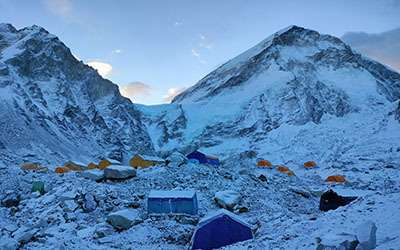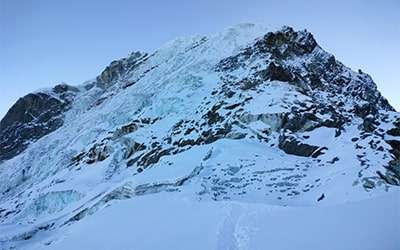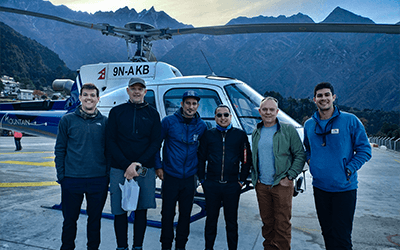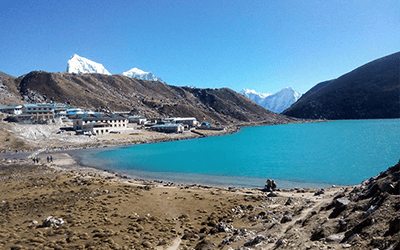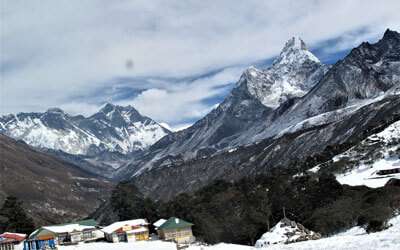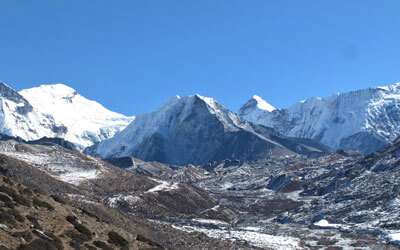FLYING TO LUKLA:
The 20 minutes’ flight to Lukla from Ramechhap Airport is one of the most thrilling experiences that delivers you the most incredible mountain flight with a view. Landing in the inclined airstrip of Lukla is something of great significance. It is always very tricky to predict the weather in the mountain. Furthermore, anyone flying high to these high altitude airports must be aware of the fact that the delays and cancellation are common episodes. Besides, anyone by any chance is flying to Lukla from Kathmandu airport they are to be aware of the fact that our international airport having one single airstrip for both international and domestic so the probability of delays is high. Thus, anyone flying to Lukla must be prepared to take the uncertainty with patience. However, it’s not a daily story. And it’s always very wise to have a contingency day in Kathmandu to cushion any cancellation situation. Though listed as a Dangerous Airport in the world the pleasure of flying to Lukla is an experience of a lifetime that is not to be missed. In fact, what’s the point of living a life of fear?
Note: The flights to and from Lukla are operated from Ramechhap airport (Another airport about 134 km from kathmandu) during the PEAK SEASONS (i.e. Mid March to Mid May and October and November) which makes the probablity of flights higher as it's a shorter flight from Ramechhap to Lukla and Planes also don't have to waste time due to air traffic. But at the same time trekkers need to drive around 5 hours to the ramechhap airport. In that period we either drive in the afternoon of Day 2 after the city tour, spend a night at Ramechhap and catch the flight next morning.
WEIGHT LIMITATION
15 Kilograms / 33 Pounds is the weight limitation in the Domestic airlines flying to Lukla and at the same time, all companies are to abide by the porter weight restrictions rules that prevail in our country. 15 Kg / 33 Lbs is your overall baggage weight that includes your daypack and your luggage. However, it doesn’t sincerely require to be an exact figure of 15 kg, 1 or 2 Kg extras per person wouldn’t make a much difference. Few things that wouldn’t count would be the items that you are taking with you in your flight like water, camera, wallet, etc. Besides, the porter luggage weight limitation is 30 kg / 66 pounds and one porter will be dealing with 2 duffel bags. So it’s always best to minimize your weight limitations. However, regarding what you need to bring carry with you is given in detail at our Trip Information page.
YOUR VALUABLE SAFETY: STORAGE:
While in Kathmandu please do not leave your room unlocked. If you are out on a short stroll or on any appointments, make sure to accommodate and secure your valuables – that can either be in your locked luggage or hotel safety deposit box.
Before we depart for our incredible adventure your leader will organize a safety store facility for your left luggage and the safety deposit box for your valuables that you wish to leave behind. However, please follow the hotel safety guideline over the loss of key to your deposit box. While trekking never leave your valuables unattained. It’s always safe to carry them on your daypack. Make sure to lock your Tea-House rooms while going out even if it’s for a short time period. In case of loss or theft please report it to the nearest police check post where you need to obtain a written report. In any such situation, your group leader would be the best person to talk to.
HEALTH:
Health is certainly significant when you are traveling to any parts of the world. To enter Nepal, there are no mandatory vaccinations. However, we suggest you to consult a doctor before you leave your country for any necessary vaccination they so choose its obligatory. We recommend you not to drink water straight from the tap. You can always drink boiled and cooled water provided by your staff or you may buy boiled and filtered water from any teahouses on the way at minimal costs.
While on your trek your leader provides you with the necessary guidelines on food to get away with food poisoning or any stomach related ailments due to new diets. However, we follow strict hygiene guidelines so all the foods in the Everest Region tea-houses are hygienically prepared under your Group leaders survey. As you all know that ‘Travellers’ Diarrhoea’ is the body’s natural reaction to new diets and new water with different mineral content. So stick to something healthy till you get acclimatized to all the new diets. Make sure you avoid too much oily food and especially meat that comes all the way from the lowland.
In case of any health issues, you can always talk to your group leader who is medically trained and counsel you with necessary precautions or medication to treat any mountain ailments that he has been trained for. You do not need to carry an extensive medical kit as your Trekking Group Leader carries a comprehensive first aid kit for the group and staff. However, we do advise you to carry your personal prescribed medicine.
PHYSICAL PREPARATION
The level of fitness is required for Everest High Passes and Island Peak Trekking as it is exclusively physical. Here we are not asking for something hard-core as we don’t consider trekking to be a contest to demonstrate your level of fitness. We believe trekking to be your ultimate holiday rather than a competition to prove how fit and strong we are. We keep a convenient pace so that your holiday is challenging but not very exhausting. You can set up your own pace and time to enjoy the most fascinating surroundings rather-than being bothered about keeping up.
Our mantra while doing any of Everest Trekking is associated with THREE ‘S’ is “Slowly, Steadily, but Surely”. Trekking is indeed a holiday being with nature, the local environment and in the wilderness, yet few weeks of physical homework is required to support you while enjoying your freedom. The best physical preparation is to walk and be conditioned with your physical strength carrying your day-pack and wearing the boots you plan to wear on the trek. 3 – 4 weeks of basic physical preparation prior to your arrival to Kathmandu will be much as necessary. Alongside, Jogging, swimming, gym workouts would add further assistance in your health fitness.
TREK ACCOMMODATION:
Accommodation at Everest High Passes and Island Peak Trekking is essentially in the tea-house that will be basic on twin bed sharing room with common toilets for parts beside Island Peak. At Island Peak base camp you will be accomodated in 2 person tents. Rooms with attached toilets and the single supplement will be provided depending on the availability as not all destinations in the Everest region offer a single supplement due to the limitation of tea-houses over the restrictions and obligations of National park rules and regulations.
FOOD ON THE TRAIL:
Kathmandu breakfast is included beside the welcome dinner in a traditional royal Nepali restaurant. All Standard Meals i.e. Breakfast, Lunch and Dinner are included in your Package along with the choice of hot beverage.We offer you an open menu so you will have a choice of your meal. Like many companies we don't limit the meals at one course however we kindly request you not to waste any food. In our entire trip, we will eat all the meals in the local Tea-houses including our lunch and our staff will make sure that your food is prepared with hygiene. And at Island Peak base camp you will be served freshly prepared meals by our exceptional cooks. You will be amazed to find the variation of food menu in such remote regions of Nepal. Furthermore, all Tea-Houses in the Everest region give their best to provide you food that is nutritious, plentiful, and tasty. We can also cater for specific dietary needs if you advise in advance besides our delicious mixture of Nepalese, Indian, Chinese, and continental food.
TIPPING GUIDANCE
Tipping is an entirely personal matter. - It is also an indication of your satisfaction with the service delivered by our local trekking crew. As they work really hard to make your holiday the most memorable one, tipping is more like a token of gratitude of saying THANK YOU to your local crew. As a guideline average tipping is around 10% of your trip cost per trekker. Many people also like to donate various items of equipment to the porters and trek staff who would very warmly receive these items. Your Group Leader will make arrangements for a fair distribution of your gratitude and the used items (possibly by raffle) amongst the trek crew. We recommend you to make separate tipping for your trekking Group Leader.
AIRPORT PORTER:
NOTE: We strongly suggest NOT TO TIP OR GIVE AWAY ANY OF YOUR BAGS to any of the AIRPORT PORTERS on your arrival in the Kathmandu Airport other than the Himalayan Dynasty Representative. Do check your bags while loading into the provided car/van for the hotel. We suggest you to separate US$ 1 OR 2 only to pay the bell boy in the Hotel.

